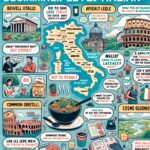Traveling Italy for beginners offers a captivating adventure through a country rich in history, culture, and stunning landscapes. From the iconic Colosseum to the charming canals of Venice, Italy has something to offer every traveler. In this guide, we will explore what to expect when visiting Italy for the first time and why it is a must-visit destination for beginners.
Whether you are drawn to the art and architecture of Rome, the culinary delights of Tuscany, or the scenic Amalfi Coast, Italy is sure to leave a lasting impression. As a beginner traveler, it’s important to plan your trip carefully to make the most of your experience in this diverse country. From selecting the best time to visit to navigating transportation and immersing in Italian culture, there are many aspects to consider when exploring Italy for the first time.
This guide will provide valuable insights into planning your trip, highlighting must-see attractions, embracing Italian culture, staying safe, and venturing beyond the big cities. By following these tips and recommendations, you can make the most of your journey through Italy and create unforgettable memories along the way. So pack your bags and get ready to embark on an unforgettable adventure in one of Europe’s most beloved destinations.
Planning Your Trip
Italy is a country with diverse attractions and experiences, making it essential for first-time travelers to plan their trip carefully. One crucial aspect of planning your trip to Italy as a beginner is researching and selecting the best time to visit. Italy experiences peak tourist seasons in the summer months, where popular destinations can be extremely crowded and accommodations are more expensive.
On the other hand, visiting during the shoulder seasons of spring or fall can offer milder weather and fewer crowds. Additionally, certain cities may have specific events or festivals that attract visitors during particular times of the year.
Deciding which cities to visit as a beginner in Italy is another important aspect of trip planning. While iconic cities like Rome, Florence, and Venice are must-see destinations for many travelers, it’s also essential to consider your personal interests and travel style when selecting locations. Each city in Italy offers its own unique attractions and ambiance, so doing thorough research on what each destination has to offer can help tailor your itinerary to your preferences.
Budgeting for your trip and finding affordable accommodations should also be considered when planning your trip to Italy. Like any travel destination, setting a budget for expenses such as accommodations, dining, transportation, and activities can help manage costs effectively. Italy offers various options for accommodations ranging from budget-friendly hostels to luxury hotels, and researching different types of lodging can help balance cost and comfort during your stay.
| Aspect | Considerations |
|---|---|
| Best Time to Visit | Summer crowds vs. milder weather in spring/fall; city-specific events |
| Selecting Cities | Research each city’s attractions and ambiance; consider personal interests |
| Budgeting | Set budget for accommodations, dining, transportation; research affordable lodging options |
Navigating Transportation
Understanding the various transportation options in Italy
Italy offers a wide range of transportation options for travelers, including trains, buses, and rental cars. The country is well-connected by an extensive railway network that makes traveling between cities convenient and efficient. The high-speed trains, known as Frecciarossa and Frecciargento, are popular choices for long-distance travel, offering comfort and speed.
Buses are also a common mode of transportation, especially for reaching smaller towns and rural areas. Additionally, renting a car provides the flexibility to explore more remote regions of Italy at your own pace.
Tips for getting around efficiently and cost-effectively
When using public transportation in Italy, it’s important to plan your routes in advance to make the most of your time. Consider purchasing rail passes or city-specific travel cards to save money on multiple journeys. Researching the best ticket options for your itinerary can help you navigate the transportation system with ease. Additionally, familiarize yourself with the schedules and operating hours of trains and buses to avoid any inconvenience during your travels.
How to use public transportation in Italian cities
In major Italian cities like Rome, Florence, and Venice, public transportation is an essential part of getting around. Each city has its own network of buses, trams, and metros that connect key attractions and neighborhoods. Purchasing tickets for public transport can be done at designated kiosks or vending machines located at stations or through mobile apps. It’s also advisable to keep an eye on pickpockets while using public transportation and hold onto valuables securely.
Must-See Attractions
When traveling to Italy for the first time, there are certain must-see attractions that should be at the top of every beginner‘s list. From iconic landmarks to historical treasures, these attractions provide a glimpse into the rich culture and history of Italy.
Highlighting the top attractions
The Colosseum in Rome, Vatican City, Florence Cathedral, and the Leaning Tower of Pisa are just a few of the must-see attractions in Italy for beginners. Each of these landmarks offers a unique and unforgettable experience that showcases Italy’s architectural prowess and historical significance. Booking tours and tickets in advance is highly recommended to avoid long lines and make the most of your time at each attraction.
How to make the most of your time
To fully appreciate these iconic attractions, it’s essential to plan your visit strategically. Researching the best times to visit each location, learning about their historical background, and understanding any cultural customs or traditions associated with them can enhance your overall experience. Taking the time to absorb the beauty and significance of each attraction will leave you with lasting memories of your trip to Italy.
Booking tours and tickets in advance
Many popular attractions in Italy offer skip-the-line passes or guided tours that provide valuable insights into their history and significance. By booking these experiences in advance, you can avoid spending unnecessary time waiting in line and ensure that you have ample time to explore each attraction at your own pace. This allows you to make the most of your visit while gaining a deeper understanding of Italy’s cultural heritage.
Immersing in Italian Culture
Italy is a country known for its rich culture and delectable cuisine, and as a beginner traveler to the country, immersing yourself in Italian culture is an essential part of the experience. Here are some tips for making the most of your cultural immersion while traveling Italy for the first time:
- Embracing the local cuisine: Italian food is celebrated worldwide, and there’s no better place to indulge in authentic pizza, pasta, gelato, and fine wines than in Italy itself. Be sure to seek out local trattorias and osterias for a genuine taste of Italian cuisine.
- Partaking in cultural activities and events: From art galleries and opera performances to traditional festivals and local markets, Italy offers a myriad of cultural experiences for visitors. Consider planning your trip around specific events or activities that interest you.
- Tips for interacting with locals: Italians are known for their warm hospitality, so don’t be afraid to engage with locals during your travels. Learning a few basic Italian phrases can go a long way in making connections and experiencing genuine interactions with the people of Italy.
By fully embracing Italian culture through its food, activities, and interactions with locals, you’ll gain a deeper appreciation for this beautiful country.
As you immerse yourself in Italian culture, keep in mind that every region in Italy has its own unique traditions, culinary specialties, and dialects. Whether you’re exploring historic sites in Rome or savoring seafood along the Amalfi Coast, understanding the diverse cultures within Italy will enrich your travel experience. Taking the time to learn about each region’s distinct customs and heritage will allow you to appreciate the nuances that make Italy such a captivating destination.
While indulging in famous attractions like the Colosseum or Vatican City is an integral part of any trip to Italy, taking time to explore small towns or lesser-known regions will provide insight into authentic Italian life. Venturing beyond major cities allows travelers to witness traditional craftsmanship, regional variations in cuisine, and centuries-old traditions that are still thriving today.
Consider embarking on day trips from major cities or dedicating a portion of your trip to experiencing the Italian countryside and coastal regions.
Safety and Practical Tips
Italy is a relatively safe country for travelers, but like any destination, it’s important to take precautions to ensure a smooth and enjoyable trip. Here are some safety and practical tips to keep in mind when traveling to Italy:
- Be aware of pickpockets, especially in crowded tourist areas. Keep your belongings secure and consider using a money belt or anti-theft bag.
- Stay vigilant when using public transportation, as theft can occur on buses and trains. Keep an eye on your belongings at all times.
- It’s recommended to carry a copy of your passport with you at all times, but keep the original secured in your accommodation.
- Be cautious of scams, including individuals attempting to distract you while an accomplice steals your belongings. Be wary of anyone overly friendly or insistent on offering help.
In addition to safety considerations, there are practical tips that can enhance your experience in Italy:
- Pack lightweight clothing and comfortable walking shoes, especially if you plan on exploring the city streets and historical sites.
- Learn some basic Italian phrases or carry a pocket phrasebook to assist with communication. While many Italians speak English, making an effort to speak their language is appreciated.
- Consider purchasing a local SIM card for your phone to have access to data for GPS navigation and staying connected while out and about.
- When dining out, be aware that it is customary in Italy to pay a coperto (cover charge) per person at restaurants. This cover charge typically includes bread and service.
By keeping these safety and practical tips in mind, you’ll be better prepared for an enriching travel experience in Italy without any unnecessary hassles or setbacks.
Exploring Beyond the Big Cities
Italy is a country known for its iconic cities like Rome, Florence, and Venice, but there’s so much more to explore beyond these popular tourist destinations. For travelers looking to experience the authentic culture and natural beauty of Italy, venturing beyond the big cities is a must. From charming small towns to breathtaking coastal regions and picturesque countryside, there are countless hidden gems waiting to be discovered.
One such hidden gem in Italy is the region of Umbria. Often overshadowed by its more famous neighbor, Tuscany, Umbria offers a quieter and more laid-back atmosphere. Visitors can explore medieval hilltop towns such as Assisi and Orvieto, taste some of the country’s best olive oils and wines, and take in the stunning landscapes dotted with vineyards and ancient ruins.
In addition to lesser-known regions, there are also plenty of enchanting coastal destinations in Italy that should not be missed. The Amalfi Coast, with its dramatic cliffs, pastel-colored fishing villages, and panoramic views of the Tyrrhenian Sea, is a perfect example. Travelers can enjoy leisurely strolls along the coastline, indulge in fresh seafood cuisine, or hop on a boat to explore secluded coves and caves.
Finally, for those who wish to escape the hustle and bustle of city life entirely, Italy’s countryside beckons with its rolling hills, vineyards, and historic farmhouses. Tuscany’s Val d’Orcia is a UNESCO World Heritage Site that offers visitors a glimpse into rural Italian life.
Whether it’s exploring charming villages like Pienza or Montepulciano or simply enjoying the tranquility of nature while sipping on local wine, experiencing these unspoiled regions is an essential part of any Italian adventure.
| Destination | Highlights |
|---|---|
| Umbria | Medieval hilltop towns like Assisi and Orvieto; Olive oil and wine tastings; Stunning landscapes |
| Amalfi Coast | Dramatic cliffs; Pastel-colored fishing villages; Fresh seafood cuisine; Scenic boat tours |
| Tuscany’s Val d’Orcia | Rural Italian villages like Pienza or Montepulciano; Vineyards; Tranquility of nature |
Making the Most of Your Trip
In conclusion, traveling to Italy as a beginner can be an enriching and unforgettable experience. By following the tips and advice outlined in this guide, first-time visitors can make the most of their trip and create lasting memories. It’s important to find a balance between sightseeing and relaxation, allowing for spontaneity and the discovery of hidden treasures. Embracing the Italian way of life, including the cuisine, cultural activities, and interactions with locals, will enhance the overall experience.
While visiting Italy, it’s essential to remember that there is so much more to explore beyond the big cities. Day trips from major cities allow for a more authentic Italian experience, while venturing into the countryside and coastal regions provides a different perspective of the country. This allows travelers to fully immerse themselves in Italian culture and appreciate the diverse landscapes that Italy has to offer.
Ultimately, making the most of a trip to Italy involves creating lasting memories and planning for a future return trip. The allure of Italy is such that one visit may not be enough to truly appreciate all that it has to offer.
Whether it’s revisiting favorite destinations or exploring new ones, Italy has a way of captivating visitors and leaving them longing for more. With careful planning, embracing spontaneity, and immersing in Italian culture, beginners can have a fulfilling and rewarding travel experience in this beautiful Mediterranean country.
Frequently Asked Questions
Where should my first trip to Italy be?
Your first trip to Italy should ideally be to the iconic cities of Rome, Florence, and Venice. These cities offer a perfect blend of history, art, culture, and cuisine that showcases the best that Italy has to offer.
Visiting these cities will give you a well-rounded introduction to Italian life and provide a strong foundation for future travels within the country.
What I wish I knew before going to Italy?
Before going to Italy, it’s important to know that many places close for an afternoon siesta and then reopen in the evening. It’s also helpful to be aware of the cultural differences in dining – Italians typically eat dinner later in the evening compared to other countries.
Additionally, knowing some basic Italian phrases can go a long way in making your experience more enjoyable as many locals might not speak English fluently.
How do I visit Italy for the first time?
Visiting Italy for the first time can be an exciting adventure. Start by researching the places you want to visit and create an itinerary based on your interests – whether it’s history, art, food, or nature. Remember to check visa requirements if necessary and ensure your passport is valid.
Look into transportation options and decide whether you’ll need to rent a car or rely on public transportation. Lastly, immerse yourself in Italian culture by trying local food, enjoying long leisurely meals, and exploring off-the-beaten-path neighborhoods for an authentic experience.

I’m a passionate traveler, writer, and Italophile. My fascination with Italy’s history, art, and culture has led me on countless adventures across the Italian landscape. Through “I Live Italy,” I share my love for this extraordinary country and aims to inspire others to explore its boundless beauty.




